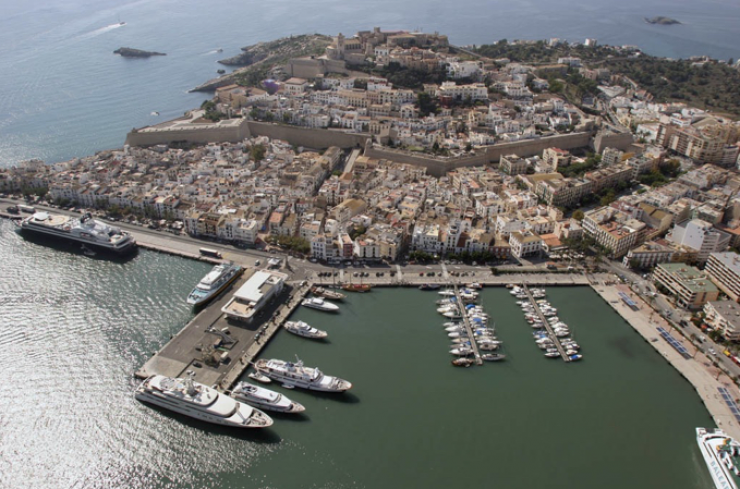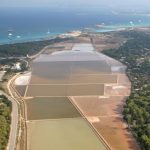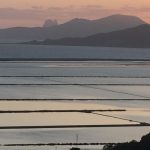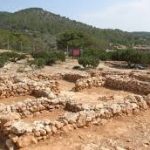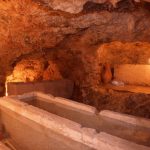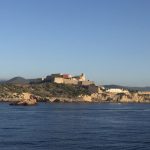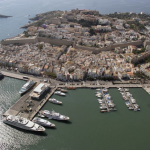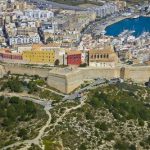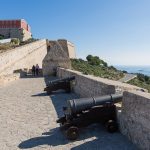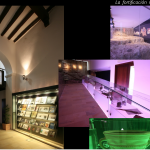Do you want to read in English? Click here.
Ibiza es una de las cuatro islas Baleares, situadas en el occidente mediterráneo. Su núcleo urbano de mayor extensión es la ciudad de Ibiza, situada junto a una bahía natural clave en la evolución económica de la ciudad desde la antigüedad.
Ibiza fue incluida en la lista de Patrimonio Mundial de 1999 con el nombre de »Ibiza, Biodiversidad y Cultura» que incluye estos cinco elementos de la isla:
-Las Murallas de Ibiza.
-La ciudad dentro de las murallas de Dalt Vila.
-La posidonia Oceánica del Parque Natural de Ses Salines.
-El asentamiento fenicio ubicado en Sa Caleta.
-La necrópolis de Puig des Molins.
La posidonia del Parque natural de Ses Salines
La Posidonia es una planta endémica del mar Mediterráneo, con hojas, tallo y fruto que crece formando extensas praderas. En grandes zonas del Mediterráneo está amenazada, pero se mantiene bien preservada en Ibiza. Aunque está protegida, actualmente su mayor amenaza son los fondeos ilegales, que arrancan la planta, la cual es la encargada de filtrar el agua y darle ese precioso tono azul cristalino que la define.
Ses Salines es un parque natural localizado entre el sur de Ibiza y el norte de Formentera. Este área se caracteriza por la presencia de extensos estanques de sal, y por ser un lugar único de anidación y zona de descanso de más de 220 especies del reino animal.
El asentamiento fenicio de Sa Caleta
Este asentamiento fue considerado por la UNESCO como un lugar de excepcional evidencia de la urbanización y vida social de las colonias fenicias de occidente. Constituyen un prototipo de urbanismo único de ese periodo histórico.
Está localizado en la zona sur-este de la isla, a 10 kilómetros de Ibiza. Este asentamiento es el primer y único encontrado en las islas Baleares sobre la cultura fenicia, y está datado entre el siglo VIII antes de Cristo.
Necrópolis de Puig des Molins
Con una superficie de unas 50000 hectáreas es considerado la más extensa y mejor preservada de las necrópolis Fenicio-Púnicas. Se encuentra casi completamente intacta. Esta necrópolis, ubicada justo al lado de Dalt Vila, fue utilizada como cementerio durante aproximadamente 1000 años, y posee 3500 hipogeos, cámaras subterráneas, cuya excavación e investigación no está agotada.
Gracias a las tumbas podemos saber que mientras los fenicios incineraban a sus muertos, los cartagineses crearon tumbas llamadas »hipogeos», cámaras cerradas con sarcófagos. Dentro de estos hipogeos se han encontrado cerámica, terracota e incluso huevos de avestruz.
La ciudad de Dalt Vila
Después de que los fenicios abandonaran el asentamiento de Sa Caleta por su imposibilidad de seguir creciendo en el, se trasladaron a la zona que ahora conocemos como Dalt Vila en el siglo VII antes de Cristo.
Con el avance del Imperio Romano los fenicios decidieron hacer una alianza y cambiaron el nombre de Aibossim a Ebussus en el siglo I antes de Cristo. No caería el Imperio Romano hasta el siglo V después de Cristo.
Dalt Vila es, sin ninguna duda, la zona más importante -culturalmente hablando- de la isla. Su nombre ha ido cambiando conforme cambiaban sus habitantes/conquistadores: Aibossim (Fenicios-Cartagineses), Ebussus(Romanos), Madina Yabisa(Árabes)… hasta llegar al nombre por el que la conocemos ahora: Dalt Vila.
Entre sus calles se encuentran:
-El museo de Puget.
-El museo de arte contemporáneo.
-El centro de interpretación Madina Yabisa.
La muralla de Ibiza
En el siglo XVI, tras sufrir numerosos ataques por los piratas, una muralla fue edificado alrededor de la ciudad para proteger a sus ciudadanos. Esta orden fue dada por el Rey Felipe II, por un proyecto de protección marítima comenzado por Carlos I en el que todas las zonas costeras del Mediterráneo tendrían muralla.
Esta labor fue llevada a cabo por el arquitecto italiano Giovani Batista Calví, quien le dio un estilo renacentista a las murallas de Ibiza y Mallorca. De todas las murallas renacentistas del Mediterráneo, solo la de Ibiza y Malta se conservan en perfecto estado, las demás han caído por la mano del tiempo o del hombre.
La muralla de Ibiza consta de siete baluartes, dos de ellos teatralizados con réplicas de los cañones y armas utilizados en esa época.
ENGLISH VERSION
Ibiza is one of the four Balearic Islands, situated at the mediterranean occident. It’s urban center of major extension is the city of Ibiza, situated next a natural bay that was the key for the economical evolution of the city since the foretime.
Ibiza was included in the list of the World Patrimony in 1999 with the name of »Ibiza, Biodiversity and Culture» that includes this five elements of the island:
-The walls of Ibiza.
-The city inside its walls, Dalt Vila.
-The Posidonea Meadows of the Natural Park of Ses Salines.
-The phoenician settlement of Sa Caleta.
-The Necropolis of Puig des Molins.
Posidonea meadows of the Natural Park of Ses Salines
Posidonea is an endemic plant with leaves, stalk and fruit that form dense prairies of Posidonia, or seagrass. In most parts of the Mediterranean Sea the Posidonea is threatened, but remains well preserved in Ibiza. Nowadays its major threat is the illegal anchorage that pull out the plant, which is in charge of giving the water its beautiful blue/crystal tone.
Ses Salines is a salt marsh natural park located between the south of Ibiza and the north of Formentera. The uniqueness of this park resides in the fact that is a resting area and nesting ground for more than 220 different wild-life species.
The Phoenician settlement of sa Caleta
This settlement was considered by the UNESCO as a exceptional evidence of the urbanitzation and social life of the phoenician colonies. They constitute a unique recourse of material from the Phoenician and Carthaginian tombs.
It is located in the south-east of the island, at 10 kilometers from Ibiza. This settlement is the first and only one found in the Balearic islands from the phoenician culture, and is dated between the 700 and 600 before Christ.
Necropolis of Puig des Molins
With a surface of 50000 square meters is considered the largest and best preserved Phoenician-Punic necropolis, It is almost entirely intact and has not been modified. This necropolis, located next to Dalt Vila, was used as a cementery for aproximately 1000 years, and posses more than 3500 subterraneal burial chambers, some of them yet to discover.
Thanks to these chambers we can know that while the phoenicians use to incinerate, the cartaghinian created tombs named »hipogeos», secluded open tombs. Inside these tombs you can find pottery, terracotta and even Ostrich eggs.
The old town of Dalt Vila
After the phoenicians left the settlement of Sa Caleta, they moved to the place we know now as Dalt Vila on the VII century Before Christ.
With Rome’s advacement the phoenicians decide to make an alliance and changed the name of the city from Aibossim to Ebussus en the II Before Christ. It wasn’t until the V century that the Rome imperium fell.
Dalt Vila is, without any doubt, the most important- culturally speaking- area in the island. Its name has been changing with their habitants/conquerors: Aibossim (Phoenicians-Carthaginians), Ebussus (Romans), Madina Yabisa (Arabs)… until getting the name that we know now: Dalt Vila.
Inside its streets you can find:
-The Puget Museum.
-The Contemporaneum art Museum.
-The interpretation center of Madina Yabisa.
The wall of Ibiza
In the XVI century, after suffering numerous attacks from the pirates, a wall was edified around the city to protect the civilians from them. This order was done by King Felipe II, to protect the mediterranean cities as a project from the former king, Carlos I.
This job was ordered to the architect Giovani Batista Calví, who gave a renacentist style to the walls of Ibiza and Mallorca. From all the renacentist walls of the Mediterranean, only the ones in Ibiza and Malta remain the same, the other ones have been destroyed by the hand of the time or de man.
Ibiza’s wall have seven bastions, two of them dramatized with a replica of the cannons and weapons used on that age.

